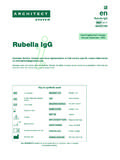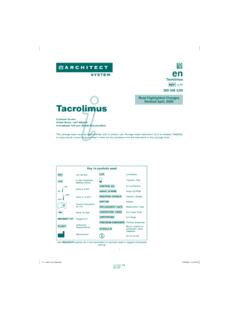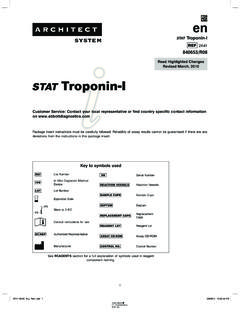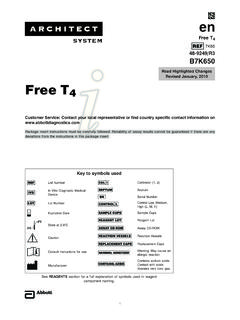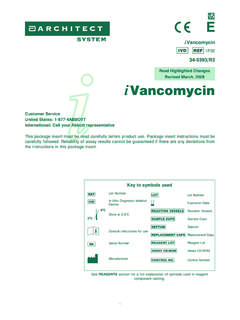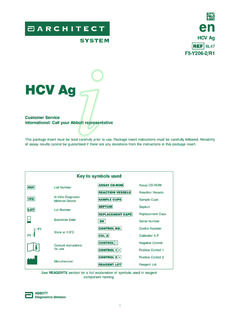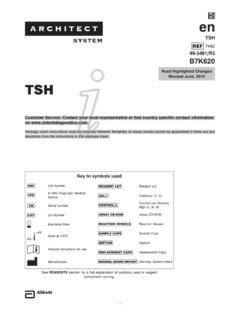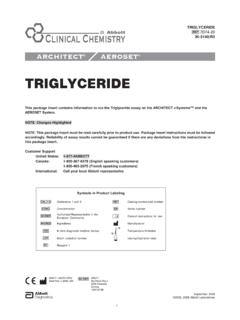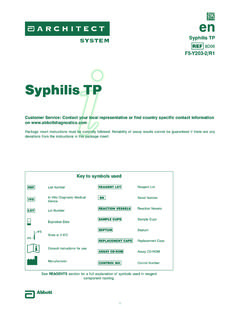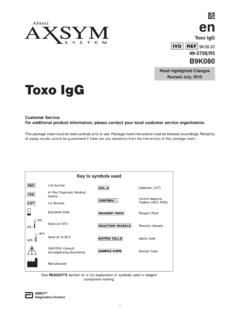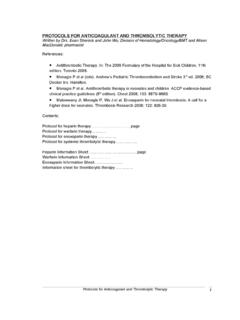Transcription of en - Ilex Medical Ltd.
1 System1i Valproic AcidKey to symbols usedList NumberIn Vitro Diagnostic Medical DeviceLot NumberExpiration DateStore at 2-8 CConsult instructions for useAuthorized RepresentativeManufacturerSerial NumberControl NumberReagent LotAssay CD-ROMR eaction VesselsSample CupsSeptumReplacement CapsSee REAGENTS section for a full explanation of symbols used in reagent component : Black Editor: OneidaDTP: Aniaeni Valproic Acid 1P35F5-O207-2/R3B1P350 Read Highlighted ChangesRevised August, 2009 Customer Service: Contact your local representative or find country specific contact information on insert instructions must be carefully followed. Reliability of assay results cannot be guaranteed if there are any deviations from the instructions in this package 19/3/2009 1:53:47 PM2 NAMEARCHITECT i Valproic AcidINTENDED USEThe ARCHITECT i Valproic Acid assay is an in vitro chemiluminescent microparticle immunoassay (CMIA) for the quantitative measurement of valproic acid, an anticonvulsant drug, in human serum or plasma on the ARCHITECT i System with STAT protocol capability.
2 The measurements obtained are used in monitoring levels of valproic acid to help ensure appropriate AND EXPLANATION OF TEST Valproic acid is a broad-spectrum anticonvulsant drug used solely or in combination with other anticonvulsant drugs for the treatment of absence ,2 It also has demonstrated effectiveness in the management of generalized tonic-clonic and myoclonic seizures, as well as atypical absence, simple and complex partial and mixed grand mal and petit mal ,3,4 The capability of treating many types of seizures with a single anticonvulsant has resulted in the wide-spread use of valproic acid, particularly in children in whom tonic-clonic and myoclonic seizures are most Valproic acid has proven effective in the treatment of many patients otherwise refractory to other anticonvulsant treatments. Most patients receiving valproic acid do not develop a tolerance to its anticonvulsant PRINCIPLES OF THE PROCEDUREThe ARCHITECT i Valproic Acid assay is a one-step STAT immunoassay for the quantitative measurement of valproic acid in human serum or plasma using CMIA technology with flexible assay protocols, referred to as , anti-valproic acid coated paramagnetic microparticles, and valproic acid acridinium-labeled conjugate are combined to create a reaction mixture.
3 The anti-valproic acid coated microparticles bind to valproic acid present in the sample and to the valproic acid acridinium-labeled conjugate. After washing, pre-trigger and trigger solutions are added to the reaction mixture. The resulting chemiluminescent reaction is measured as relative light units (RLUs). An indirect relationship exists between the amount of valproic acid in the sample and the RLUs detected by the ARCHITECT i System additional information on system and assay technology, refer to the ARCHITECT System Operations Manual, Section Kit, 100 TestsARCHITECT i Valproic Acid Reagent Kit (1P35) 1 Bottle ( mL) Anti-valproic acid (mouse, monoclonal) coated goat anti-mouse (GAM) microparticles in TRIS buffer with protein (bovine) stabilizer. Preservative: ProClin 950. 1 Bottle ( mL) Valproic acid acridinium-labeled conjugate in MES buffer with surfactant.
4 Minimum concentration: ng/mL. Preservative: ProClin ReagentsARCHITECT i Pre-Trigger Solution Pre-Trigger Solution containing (w/v) hydrogen peroxide. ARCHITECT i Trigger Solution Trigger Solution containing N sodium hydroxide. ARCHITECT i Wash Buffer Wash Buffer containing phosphate buffered saline solution. Preservative: antimicrobial AND PRECAUTIONS For In Vitro Diagnostic insert instructions must be carefully followed. Reliability of assay results cannot be guaranteed if there are any deviations from the instructions in this package PrecautionsCAUTION : This product requires the handling of human specimens. It is recommended that all human sourced materials be considered potentially infectious and be handled in accordance with the OSHA Standard on Bloodborne Biosafety Level 210 or other appropriate biosafety practices11,12 should be used for materials that contain or are suspected of containing infectious components contain methylisothiazolones, which are components of ProClin, and are classified per applicable European Community (EC) Directives as: Irritant (Xi).
5 The following are the appropriate Risk (R) and Safety (S) phrases:R43 May cause sensitization by skin contact with material and its container must be disposed of in a safe suitable swallowed, seek Medical advice immediately and show this container or microparticles contain sodium azide. Contact with acids liberates very toxic gas. This material and its container must be disposed of in a safe information on the safe disposal of sodium azide and a detailed discussion of safety precautions during system operation, refer to the ARCHITECT System Operations Manual, Section PrecautionsDo not use reagent kits beyond the expiration date. Do not pool reagents within a kit or between reagent kits. Before loading the ARCHITECT i Valproic Acid Reagent Kit on the system for the first time, the microparticle bottle requires mixing to resuspend microparticles that have settled during shipment.
6 For microparticle mixing instructions, refer to the PROCEDURE, Assay Procedure section of this package MUST be used to prevent reagent evaporation and contamination and to ensure reagent integrity. Reliability of assay results cannot be guaranteed if septums are not used according to the instructions in this package avoid contamination, wear clean gloves when placing a septum on an uncapped reagent a septum has been placed on an open reagent bottle, do not invert the bottle as this will result in reagent leakage and may compromise assay time, residual liquids may dry on the septum surface. These are typically dried salts, which have no effect on assay a detailed discussion of handling precautions during system operation, refer to the ARCHITECT System Operations Manual, Section InstructionsDo not freeze ARCHITECT i Valproic Acid reagents. The ARCHITECT i Valproic Acid Reagent Kit must be stored at 2-8 C in an upright position and may be used immediately after removal from 2-8 C stored and handled as directed, reagents are stable until the expiration ARCHITECT i Valproic Acid Reagent Kit may be stored on board the ARCHITECT i System with STAT protocol capability for a maximum of 30 days.
7 After 30 days, the reagent kit must be discarded. For information on tracking onboard time, refer to the ARCHITECT System Operations Manual, Section may be stored on or off the ARCHITECT i System. If reagents are removed from the system, store them at 2-8 C (with septums and replacement caps) in an upright position. For reagents stored off the system, it is recommended that they be stored in their original trays and boxes to ensure they remain upright. If the microparticle bottle does not remain upright (with a septum installed) while in refrigerated storage off the system, the reagent kit must be discarded. For information on unloading reagents, refer to the ARCHITECT System Operations Manual, Section of Reagent DeteriorationWhen a control value is out of the specified range, it may indicate deterioration of the reagents or errors in technique. Associated test results are invalid and samples must be retested.
8 Assay recalibration may be necessary. For troubleshooting information, refer to the ARCHITECT System Operations Manual, Section 29/3/2009 1:53:48 PM3 INSTRUMENT PROCEDUREThe ARCHITECT i Valproic Acid assay file must be installed on the ARCHITECT i System with STAT protocol capability from an ARCHITECT assay CD-ROM before performing the assay (refer to the PROCEDURE, Materials Required but not Provided section). For detailed information on assay file installation and on viewing and editing assay parameters, refer to the ARCHITECT System Operations Manual, Section information on printing assay parameters, refer to the ARCHITECT System Operations Manual, Section a detailed description of system procedures, refer to the ARCHITECT System Operations default result unit for the ARCHITECT i Valproic Acid assay is g/mL. Alternate result units, mol/L or mg/L, may be selected for reporting results by editing assay parameter Result concentration units to mol/L or mg/L.
9 The conversion formulas used by the system are as follows:Conversion Formula: (Concentration in g/mL) x ( ) = mol/LConversion Formula: (Concentration in g/mL) x ( ) = mg/LSPECIMEN COLLECTION AND PREPARATION FOR ANALYSISS pecimen TypesThe specimen collection tubes listed below were verified to be used with the ARCHITECT i Valproic Acid assay. Other specimen collection tubes, including gel separation tubes, have not been tested with this serum Human plasma collected in: lithium heparin sodium heparin potassium EDTA sodium EDTA Plasma samples from different anticoagulant tube types should not be used interchangeably for monitoring valproic anticoagulants may have a dilution effect resulting in lower concentrations for individual patient ARCHITECT i System does not provide the capability to verify specimen type. It is the responsibility of the operator to verify that the correct specimen types are used in the ARCHITECT i Valproic Acid ConditionsDo not use specimens with the following conditions: heat-inactivated specimens grossly hemolyzed (>500 mg/dL) obvious microbial contamination cadaver specimens or any other body fluids For accurate results, serum and plasma specimens should be free of fibrin, red blood cells, and other particulate matter.
10 Serum specimens from patients receiving anticoagulant or thrombolytic therapy may contain fibrin due to incomplete clot caution when handling patient specimens to prevent cross contamination. Use of disposable pipettes or pipette tips is optimal results, inspect all specimens for bubbles. Remove bubbles with an applicator stick before analysis. Use a new applicator stick for each specimen to prevent cross contamination. Preparation for AnalysisFollow the tube manufacturer s processing instructions for serum and plasma collection tubes. Gravity separation is not sufficient for specimen thawed specimens thoroughly by low speed vortexing or by inverting 10 times. Visually inspect the specimens. If layering or stratification is observed, continue mixing until specimens are visibly ensure consistency in results, specimens must be transferred to a centrifuge tube and centrifuged before testing ifthey contain fibrin, red blood cells, or other particulate matter, they require repeat testing, or they were frozen and thawed.
